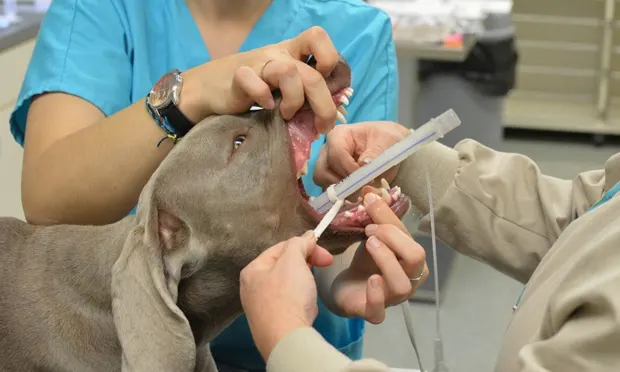Orotracheal Intubation in Dogs & Cats
Ashley J. Wiese, DVM, MS, DACVAA, MedVet

Orotracheal intubation is indicated during general anesthesia or when airflow is compromised and a patient’s airway must be secured.
A laryngoscope is recommended for all intubations. An endotracheal tube that approximates the size of the trachea should be selected and should slide easily and not snugly into the trachea. The dog should be placed in sternal recumbency with the head supported in an elevated and extended position, taking care to avoid compression of the ventral neck. Once an adequate depth of anesthesia is achieved, as determined by loss of jaw tone and the swallowing reflex, the dog is ready to be intubated.
The anesthetist places the blade of the laryngoscope on the tongue with the tip of the laryngoscope resting just underneath the epiglottis. Firm downward pressure is applied at the tip of the blade to draw the epiglottis down and optimize visualization of the epiglottis and arytenoids. The endotracheal tube is passed over the top and then behind the epiglottis, aiming between the arytenoids. The tip of the endotracheal tube should be directed below the visible arytenoids where the airway opening is wider.
Using the dominant hand, the anesthetist advances the endotracheal tube orally between the arytenoids. Once the endotracheal tube is appropriately positioned and before the inhalant anesthetic is turned on, the endotracheal tube cuff is inflated with just enough air to make a seal. Correct placement of the endotracheal tube is confirmed utilizing a number of possible methods.
The technique for orotracheal intubation in cats is similar to that for dogs, with a few notable differences. Cats frequently develop laryngospasm, making intubation without topical anesthetic challenging. A rigid stylet placed inside the endotracheal tube may be used to stiffen the endotracheal tube to facilitate orotracheal intubation in cats, but is not always necessary.
In summary, orotracheal intubation can be accomplished with little difficulty when proper equipment, technique, and positioning are employed. For step-by-step instruction in both canine and feline patients, watch the video below.